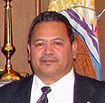Japanese settlement in Palau
|
|||||
| Total population | |||||
|---|---|---|---|---|---|
| 300 (2009) | |||||
| Regions with significant populations | |||||
| Angaur, Koror | |||||
| Languages | |||||
| Palauan, English, Japanese | |||||
| Religion | |||||
| Roman Catholicism and ProtestantismShintoism and Buddhism | |||||
| Related ethnic groups | |||||
| Palauans, Japanese, Okinawans | |||||
There is a small Japanese community in Palau, which mainly consists of Japanese expatriates residing in Palau over a long-term basis. A few Japanese expatriates started to reside in Palau after it gained independence in 1994, and established long-term businesses in the country. Japanese settlement in Palau dates back to the early 19th century, although large scale Japanese migration to Palau did not occur until the 1920s, when Palau came under Japanese rule and administered as part of the South Pacific Mandate. Japanese settlers took on leading administrative roles in the Japanese colonial government, and developed Palau's economy. After the Japanese surrender in 1945, virtually all of the Japanese population was repatriated back to Japan, although people of mixed Japanese-Palauan descent were allowed to remain behind. People of Japanese-Palauan descent constitute a large minority of Palau's population as a result of substantial intermarrriage between the Japanese settlers and Palauans. They generally identify with, conforming to cultural norms and daily lives with the Palauans.
The first recorded account of Japanese contact in Palau occurred in 1820, when a coastal sailing ship was blown off course and eight surviving men spent five years in Palau until 1825. Japanese traders began to establish settlements from the mid-19th century onwards, and by 1890 two Japanese trading stations had been established. Many of these traders married the daughters of local chieftains and raised local families. When Japan annexed Palau from Germany in 1914, Japanese settlers and their descendants acted as state liaison officials and interpreters for the Japanese military administration.
A civilian government was established in 1922 with its headquarters at Koror, replacing the military administration. The civilian government initiated a programme to identify and collectivise unused land between 1923 and 1932 for redevelopment. Much of these land were used to build new industrial estates and expand towns to accommodate immigrants from Japan and Okinawa. In Japan, the government actively encouraged the Japanese and Okinawans to resettle in Micronesia, including Palau, and began establishing farming settlements. The first farming settlement was established at Ngaremlengui in 1926, but the settlers encountered problems with its humid tropical environment and abandoned it by 1930, although later settlements were established more successfully.
...
Wikipedia




